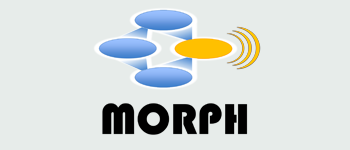
MORPH
Marine robotic system of self-organizing, logically linked physical nodes
| Project Information | |
|---|---|
| Funding Agency | EU FP7 |
| My Role | Senior Researcher |
| Project Website | http://morph-project.eu |
| Duration | February 2012 to January 2016 |
| Coordinator | Atlas Elektronik GmbH, Germany |
| Partners | NATO Center for Marine Research and Experimentation, Italy |
| Jacobs University Bremen gGmbH, Germany | |
| Technical University Ilmenau, Germany | |
| University of Girona, Spain | |
| Institut Francais de Recherche pour l'Exploitation de la Mer (ifremer), France | |
| Consiglio Nazionale delle Ricerche (CNR), Italy | |
| IMAR - Instituto do Mar, Azores, Portugal | |
| Instituto Superior Tecnico, Lisbon, Portugal | |
| Atlas Hydrographics GmbH, Germany | |
My role in the project
As a senior researcher, I was responsible for the co-supervision of contributions from Jacobs University to opto-acoustic simultaneous localization and mapping (SLAM) and stereo camera sensing as well as some coordination with international research partners. My own research contributions focused on robust SLAM methods, mainly implemented with stereo cameras. I was also responsible for producing technical and financial reports to the EC.
Executive Summary
The MORPH project focused on multi-vehicle large-scale underwater 3D mapping surveys. It investigated topics such as multi-vehicle distributed formation control, relative (opto-acoustic) localization, multi-vehicle acoustic networking, and visual simultaneous localization and mapping. The system, consisting of up to five vehicles contributed by different partners, was tested in multiple sea trials in France, Spain, and the Azores.
Video - Azores 2014
Video - St.Feliu 2015
Project Objectives
The MORPH project advances the novel concept of an underwater robotic system composed of a number of spatially separated mobile robot-modules, carrying distinct and yet complementary resources. Instead of being physically coupled, the modules are connected via virtual links that rely on the flow of information among them, i. e. inter-module interactions are allowed by underwater communication networks at distant and close ranges and supported by visual perception at very close range. The MORPH supra-vehicle (MSV) is thus in sharp contrast to classical monolithic vehicles or even cooperative groups of marine vehicles that operate safely away from each other. These lack the capability of mutual support and multi-sensor interaction.Without rigid links, the MSV can reconfigure itself and adapt in response to the shape of the terrain. This capability provides the foundation for efficient methods to map the underwater environment with great accuracy especially in situations that defy existing technology: namely, underwater surveys over rugged terrain and structures with full 3D complexity. This includes walls with a negative slope, where precise localization of a single vehicle is not possible.The possible applications of the MSV cover a wide range of scientific and commercial areas such as monitoring of cold water coral reefs, oil and gas pipeline inspection, or harbor and dam protection. The common characteristic of these areas is the need for operating multiple, complementary instruments at very close range to unstructured underwater terrain while accomplishing proper geo-referencing at the same time.The MORPH concept requires qualitatively new behaviors such as adaptive sensor placement for perception and navigation, as well as environmental modeling in complex environments. On site view planning will lead to a solution well beyond the operational state of the art for underwater cliff surveys and other similar missions. A final demonstration on a vertical cliff, unfeasible automatically with today’s technology, will validate the efficacy of the methods developed.